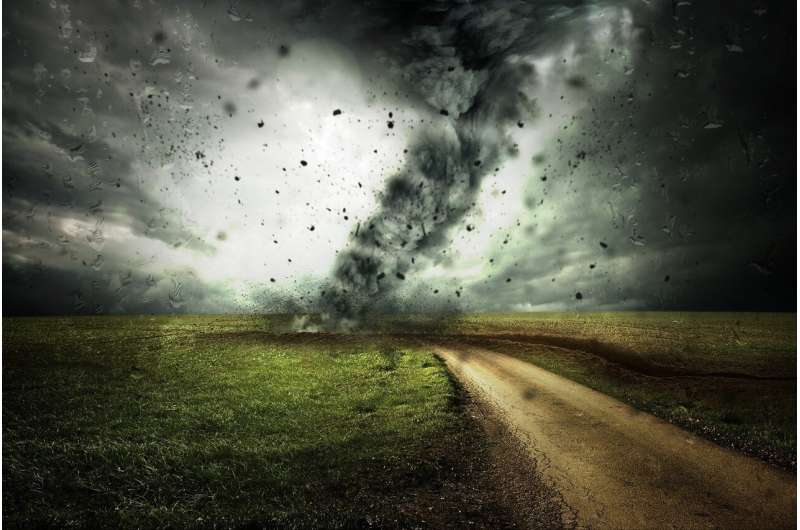This article has been reviewed according to Science X's editorial process and policies. Editors have highlighted the following attributes while ensuring the content's credibility:
fact-checked
peer-reviewed publication
trusted source
proofread
Doom-and-gloom climate news may scare but also encourage audiences

A team of Penn State researchers investigated how seeing frightening news about climate change day after day may shape the way people feel about the phenomenon and how willing they are to take action to address it.
Christofer Skurka, Jessica Myrick and graduate student Yin Yang found that seeing bad news about climate change can make people more afraid over time, but it also may encourage audiences to think about what society can do to address the problem. They published the results of two separate studies in an article titled, "Fanning the flames or burning out? Testing competing hypotheses about repeated exposure to threatening climate change messages," which appeared in the journal Climatic Change.
"The public is surrounded by media coverage about climate change, and this messaging tends to be negative in tone, focusing on the threats that climate change poses to human prosperity and ecological health," said Skurka, the paper's lead author and an assistant professor of media studies in the Donald P. Bellisario College of Communications. "We know from years of research in the field of communication that media messaging can impact our emotions, our beliefs and, in turn, sometimes our behavior."
The first study involved exposing participants to three days of negative news stories about climate change. A follow-up study consisted of participants reading negative news headlines about climate change in the form of Twitter posts for seven consecutive days.
"We found that three days in a row of reading doom-and-gloom news stories about climate change was linked to greater fear and less hope, which can potentially hurt an audience's attitude that they can do anything to tackle the problem," said Myrick, the Donald P. Bellisario Professor of Health Communication and faculty member of the Institutes of Energy and the Environment. "However, our follow-up study had people look only at headlines and not full news stories for a longer period of seven days in a row. In that study, we found that fear peaked after a few days and then held steady."
The researchers reported that over time, people who repeatedly saw climate change headlines started to feel like they could do more to affect change and that the topic of climate change was important.
"You would think that as people are repeatedly exposed to threatening climate news devoid of solutions content that their efficacy beliefs will decrease over time," Skurka said. "We saw the opposite pattern in our second study. People's efficacy beliefs increased over time. In other words, the more exposure people had to these threatening news stories each day, they were increasingly likely to think that they can make a difference in addressing climate change."
Skurka said one possibility is that as the public copes with unpleasant feelings about the enormous threat climate change presents, they may convince themselves that they have control over the situation, which translates into greater efficacy beliefs that their actions will make a difference.
"Our findings suggest that people have gotten used to doom-and-gloom reporting around climate change and what may be more important for motivating them to take action is that they see coverage of it on a daily basis," Myrick said. "This is called an agenda-setting effect, where a topic that is covered more often in the news is then viewed as more important by people who consume the news."
According to Skurka, decades of research in communication and psychology show that under certain circumstances, fear can be motivating.
"We found that people exposed to the high-threat headlines, which tended to evoke more fear, generally expressed greater intentions to share the information than people exposed to the low-threat headlines, which means there may be an advantage to evoking fear," Skurka said.
"However, people's responses over time were essentially the same regardless of whether they were shown the high-threat or low-threat news headlines. That tells us that when it comes to over-time responses to repeated media exposure, simply mentioning climate change in the news activates pre-existing emotions and thoughts associated with climate change."
Myrick added that this does not mean that fear-appeals should be used for all climate change communication. Instead, the more important factor may be communicating hope and solutions.
"For communication to be most impactful, people need to feel like there is still something we can do about it to make a difference," Myrick said. "That should hopefully motivate reporters and strategic communicators to include information about solutions to climate change in their messaging."
More information: Chris Skurka et al, Fanning the flames or burning out? Testing competing hypotheses about repeated exposure to threatening climate change messages, Climatic Change (2023). DOI: 10.1007/s10584-023-03539-8
Journal information: Climatic Change
Provided by Pennsylvania State University




















